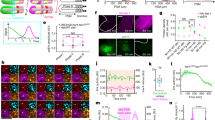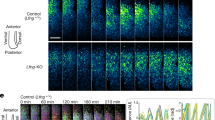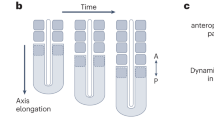Abstract
The segmented aspect of the vertebrate body plan first arises through the sequential formation of somites. The periodicity of somitogenesis is thought to be regulated by a molecular oscillator, the segmentation clock, which functions in presomitic mesoderm cells. This oscillator controls the periodic expression of ‘cyclic genes’, which are all related to the Notch pathway1,2,3,4,5,6,7. The mechanism underlying this oscillator is not understood. Here we show that the protein product of the cyclic gene lunatic fringe (Lfng), which encodes a glycosyltransferase that can modify Notch activity, oscillates in the chick presomitic mesoderm. Overexpressing Lfng in the paraxial mesoderm abolishes the expression of cyclic genes including endogenous Lfng and leads to defects in segmentation. This effect on cyclic genes phenocopies inhibition of Notch signalling in the presomitic mesoderm. We therefore propose that Lfng establishes a negative feedback loop that implements periodic inhibition of Notch, which in turn controls the rhythmic expression of cyclic genes in the chick presomitic mesoderm. This feedback loop provides a molecular basis for the oscillator underlying the avian segmentation clock.
This is a preview of subscription content, access via your institution
Access options
Subscribe to this journal
Receive 51 print issues and online access
$199.00 per year
only $3.90 per issue
Buy this article
- Purchase on Springer Link
- Instant access to full article PDF
Prices may be subject to local taxes which are calculated during checkout




Similar content being viewed by others
References
McGrew, M. J., Dale, J. K., Fraboulet, S. & Pourquie, O. The lunatic fringe gene is a target of the molecular clock linked to somite segmentation in avian embryos. Curr. Biol. 8, 979–982 (1998)
Aulehla, A. & Johnson, R. L. Dynamic expression of lunatic fringe suggests a link between notch signaling and an autonomous cellular oscillator driving somite segmentation. Dev. Biol. 207, 49–61 (1999)
Forsberg, H., Crozet, F. & Brown, N. A. Waves of mouse Lunatic fringe expression, in four-hour cycles at two-hour intervals, precede somite boundary formation. Curr. Biol. 8, 1027–1030 (1998)
Palmeirim, I., Henrique, D., Ish-Horowicz, D. & Pourquié, O. Avian hairy gene expression identifies a molecular clock linked to vertebrate segmentation and somitogenesiss. Cell 91, 639–648 (1997)
Jouve, C. et al. Notch signalling is required for cyclic expression of the hairy-like gene HES1 in the presomitic mesoderm. Development 127, 1421–1429 (2000)
Holley, S. A., Geisler, R. & Nusslein-Volhard, C. Control of her1 expression during zebrafish somitogenesis by a delta-dependent oscillator and an independent wave-front activity. Genes Dev. 14, 1678–1690 (2000)
Jiang, Y. J. et al. Notch signalling and the synchronization of the somite segmentation clock. Nature 408, 475–479 (2000)
Maroto, M. & Pourquie, O. A molecular clock involved in somite segmentation. Curr. Top. Dev. Biol. 51, 221–248 (2001)
Pourquie, O. & Tam, P. P. A nomenclature for prospective somites and phases of cyclic gene expression in the presomitic mesoderm. Dev. Cell 1, 619–620 (2001)
Holley, S. A., Julich, D., Rauch, G. J., Geisler, R. & Nusslein-Volhard, C. her1 and the notch pathway function within the oscillator mechanism that regulates zebrafish somitogenesis. Development 129, 1175–1183 (2002)
Hrabe de Angelis, M., McIntyre, J. & Gossler, A. Maintenance of somite borders in mice requires the Delta homologue DII1. Nature 386, 717–721 (1997)
Conlon, R. A., Reaume, A. G. & Rossant, J. Notch1 is required for the coordinate segmentation of somites. Development. 121, 1533–1545 (1995)
del Barco Barrantes, I. et al. Interaction between Notch signalling and Lunatic Fringe during somite boundary formation in the mouse. Curr. Biol. 9, 470–480 (1999)
Morales, A. V., Yasuda, Y. & Ish-Horowicz, D. Periodic Lunatic fringe expression is controlled during segmentation by a cyclic transcriptional enhancer responsive to Notch signaling. Dev. Cell 3, 63–74 (2002)
Hirata, H. et al. Oscillatory expression of the bHLH factor Hes1 regulated by a negative feedback loop. Science 298, 840–843 (2002)
Dubrulle, J., McGrew, M. J. & Pourquie, O. FGF signaling controls somite boundary position and regulates segmentation clock control of spatiotemporal Hox gene activation. Cell 106, 219–232 (2001)
Evrard, Y. A., Lun, Y., Aulehla, A., Gan, L. & Johnson, R. L. lunatic fringe is an essential mediator of somite segmentation and patterning. Nature 394, 377–381 (1998)
Zhang, N. & Gridley, T. Defects in somite formation in lunatic fringe-deficient mice. Nature 394, 374–377 (1998)
Mansouri, A. et al. Paired-related murine homeobox gene expressed in the developing sclerotome, kidney, and nervous system. Dev. Dyn. 210, 53–65 (1997)
Sato, Y., Yasuda, K. & Takahashi, Y. Morphological boundary forms by a novel inductive event mediated by Lunatic fringe and Notch during somitic segmentation. Development 129, 3633–3644 (2002)
Panin, V. M., Papayannopoulos, V., Wilson, R. & Irvine, K. D. Fringe modulates Notch–ligand interactions. Nature 387, 908–912 (1997)
Munro, S. & Freeman, M. The notch signalling regulator fringe acts in the Golgi apparatus and requires the glycosyltransferase signature motif DXD. Curr. Biol. 10, 813–820 (2000)
Moloney, D. J. et al. Fringe is a glycosyltransferase that modifies Notch. Nature 406, 369–375 (2000)
Bruckner, K., Perez, L., Clausen, H. & Cohen, S. Glycosyltransferase activity of Fringe modulates Notch–Delta interactions. Nature 406, 411–415 (2000)
Waltzer, L., Bourillot, P., Sergeant, A. & Manet, E. RBP-jκ repression activity is mediated by a co-repressor and antagonised by the Epstein Barr virus transcription factor EBNA2. Nucleic Acids Res. 23, 4939–4945 (1995)
Schroeter, E. H., Kisslinger, J. A. & Kopan, R. Notch-1 signalling requires ligand-induced proteolytic release of intracellular domain. Nature 393, 382–386 (1998)
Cole, S. E., Levorse, J. M., Tilghman, S. M. & Vogt, T. F. Clock regulatory elements control cyclic expression of Lunatic Fringe during somitogenesis. Dev. Cell 3, 75–84 (2002)
De Strooper, B. et al. A presenilin-1-dependent γ-secretase-like protease mediates release of Notch intracellular domain. Nature 398, 518–522 (1999)
Henrique, D. et al. Expression of a Delta homologue in prospective neurons in the chick. Nature 375, 787–790 (1995)
Acknowledgements
We thank A.-C. Petit for help with analysing the Lfng mRNA expression profile; J. P. Rey for technical assistance; K. Katsube, D. Henrique, S. Mackem, O. Saitoh, E. Olson, M. Wolfe, A. Israel and R. Kopan for reagents; P. Torregrossa for help with statistical analysis; R. Kageyama for sharing unpublished information; T. Lecuit, S. Kerridge, D. Ish-Horowicz, M. Wolfe, M. Placzek, C. Hudson, J. Dubrulle, T. Iimura, S. Millet and V. Baubet for comments on the manuscript. This work was supported by a Wellcome Prize Travelling Research Fellowship, an EMBO Long term Fellowship, and a Fondation pour la recherche médicale (FRM) Postdoctoral Fellowship to J.K.D, a Marie Curie Individual Fellowship from the European Commission to M.M., and the laboratory was supported by funding from Centre national de la recherche scientifique (CNRS), Human Frontiers Science Programme Organisation (HESPO), Association franc¸aise contre les myopathies (AFM) and the Universite de la méditerranée-AP de Marseille.
Author information
Authors and Affiliations
Corresponding author
Ethics declarations
Competing interests
The authors declare that they have no competing financial interests.
Rights and permissions
About this article
Cite this article
Dale, J., Maroto, M., Dequeant, ML. et al. Periodic Notch inhibition by Lunatic Fringe underlies the chick segmentation clock. Nature 421, 275–278 (2003). https://doi.org/10.1038/nature01244
Received:
Accepted:
Published:
Issue Date:
DOI: https://doi.org/10.1038/nature01244
This article is cited by
-
Nfinder: automatic inference of cell neighborhood in 2D and 3D using nuclear markers
BMC Bioinformatics (2023)
-
Notch signaling pathway: architecture, disease, and therapeutics
Signal Transduction and Targeted Therapy (2022)
-
Understanding paraxial mesoderm development and sclerotome specification for skeletal repair
Experimental & Molecular Medicine (2020)
-
Dynamical states, possibilities and propagation of stress signal
Scientific Reports (2017)
-
The CSL proteins, versatile transcription factors and context dependent corepressors of the notch signaling pathway
Cell Division (2016)
Comments
By submitting a comment you agree to abide by our Terms and Community Guidelines. If you find something abusive or that does not comply with our terms or guidelines please flag it as inappropriate.



